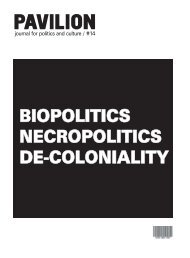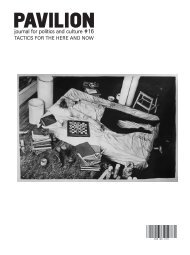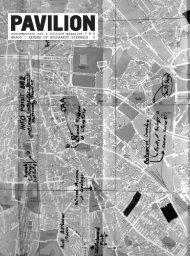PAVILION
PAVILION
PAVILION
- No tags were found...
Create successful ePaper yourself
Turn your PDF publications into a flip-book with our unique Google optimized e-Paper software.
meetings and the factory square meeting (a<br />
communist informal and systematic meeting<br />
form, where all the members of a facility<br />
were amassed to formed a square formation<br />
with an open side; the workers were praised<br />
or criticized in front of all the other people,<br />
including for their personal life). Now the<br />
APACA workers had to justify at their working<br />
place not only their professional activity,<br />
but also their personal life. The decree gave<br />
men the possibility to free themselves of any<br />
responsibility concerning their family life,<br />
except the financial support. As the access<br />
to contraceptive methods was prohibited,<br />
the women became children production<br />
units, and they took automatically the<br />
responsibility for the children’s education.<br />
The women comrades from the factory<br />
could trust no one any longer, as anybody<br />
might be an informer. They had no chance to<br />
avoid the system; their only option was to<br />
obey the rules. The stress was governing<br />
their lives, although was known in the communist<br />
block as ‘the capitalism disease”. In<br />
the ‘70s APACA was among the few factories<br />
that were still functioning at full capacity,<br />
so as to set a good example for the<br />
Romanian industry.<br />
The repression in a primitive vulgarity<br />
became their only retreat, and it was<br />
propped up by envy and hatred towards the<br />
intellectuals and those who managed to isolate<br />
from the rules ad the restrictions of the<br />
system and who assumed their freedom<br />
(insofar as this was possible). This way, they<br />
had an opportunity to ignore their problematic<br />
existence. Their social life was reduced to<br />
tattling on the social life of those they<br />
despised.<br />
The APACA women took part in all the panegyrical<br />
marches and shows that acclaimed<br />
the Ceau[escu spouses and the “achievements”<br />
of the Romanian party and people.<br />
Their conformism provided them with the<br />
comfort granted by the lack of personal concerns,<br />
transforming them into easily manipulated<br />
propaganda agents. The factory was<br />
often visited by high officials of the<br />
Communist Party, and it functioned as a laboratory<br />
for experimenting social control programs;<br />
the workers reacted mimetically, as<br />
they were expected to.<br />
For the Party APACA kindergarten was<br />
another object of pride. The new communists<br />
were forged here. Șoimii Patriei<br />
(approx. “Fatherland’s Falcons”, communist<br />
form of organization for the school and preschool<br />
Romanian children between 4 and 7,<br />
founded in 1976) was meant to contribute to<br />
the ethical and civic education of the children,<br />
in the spirit of humanity, love for the<br />
fatherland and the people, for the Romanian<br />
Communist Party. Women brought their children<br />
here every Monday morning and took<br />
them back home only in Sunday evening.<br />
Because of the exhausting work schedule,<br />
rarely a mother visited the children during<br />
the week. The position achieved by the children<br />
from APACA kindergarten was a very<br />
special one: they were favoured by the<br />
model citizen files that their parents had<br />
(PCR had files for all the Romanian citizens,<br />
and they determined the individuals’ social<br />
position and status). Children of low extraction,<br />
from modest worker families, without<br />
any academic degrees, were preferred by<br />
the Party; it was thought they would accomplish<br />
the New Man ideal, so they grew up in<br />
very special conditions, better than in their<br />
homes. They never lack indoor heating,<br />
while other children of their age were freezing<br />
in cold, dilapidated kindergartens; they<br />
were permanently fed with meat products,<br />
eggs, and milk, even though one couldn’t<br />
find such stuff in any store. Over 500 children<br />
between 2-8 years were educated to<br />
become trusted men of the system right in<br />
that factory, the former military barracks. Of<br />
course, they were constantly visited by the<br />
high officials’ wives, and they participated at<br />
all the festivities honouring Ceaușescu<br />
spouses.<br />
Although they were expected to have a different<br />
kind of reaction after 1989, the<br />
APACA workers continued to support the<br />
neocommunist system that went on functioning<br />
in Romania. During the street riots<br />
from University Square, in Bucharest, in the<br />
fights between revolutionaries and the state<br />
forces, the miners engaged in the battle<br />
against the students, as ordered by the<br />
president Ion Iliescu. At that moment APACA<br />
women got out in the streets, acclaiming the<br />
miners and their violent interventions, with<br />
many wounded and dead people. They were<br />
also chanting “Death for the students!” and<br />
“Death for the intellectuals!”, while they<br />
enjoyed watching the miners beating up,<br />
coldbloodedly, any youngster that seemed<br />
to be a student.<br />
After 1992 most of the APACA sectors<br />
closed down or privatized, and the vast<br />
majority of the workers was forced to search<br />
for a new job. The women still working at<br />
APACA have now children who have<br />
become students (as those they wanted<br />
dead a few years ago), but they still accept<br />
to be the victims of the political and election<br />
campaigns; they still sell their vote for a<br />
flower at Woman’s Day or a concert with the<br />
manelists of the day, that bring tears in their<br />
eyes. (A manelist is a manea singer; the<br />
manea is a sinister combination between the<br />
gipsy fiddler music and Oriental tunes, promoting<br />
a basic and primitive lifestyle, centered<br />
upon material values - luxurious cars,<br />
wealthy husbands, big houses, etc.)<br />
The APACA women’s case can stand as an<br />
example for the way it functioned - and it is<br />
still functioning - the manipulation in the<br />
communist regime, in the neocommunist<br />
one, and then in the capitalist regime. Using<br />
the systematic repression, the permanent<br />
control and the restriction of any independent<br />
action, all the systems have managed to<br />
transform the human beings into auxiliary<br />
machines of the system - of any system.<br />
This type of systematic and highly aggressive<br />
oppression came from the system, was<br />
accepted by most of the citizens, and<br />
exhausted all the personal resources for<br />
many Romanians, apparently leaving them<br />
without any other option, except the social<br />
compliance and mimetism.<br />
Why did those women continue to assume<br />
their function as instruments of a system<br />
that, theoretically, had ceased to exist after<br />
1989? Why did the APACA women reject,<br />
with such hatred and contempt, the new<br />
democratic concepts and the new kind of<br />
morality, based on individuality and freedom<br />
of expression? The answer may be found in<br />
their own history, which overlaps the history<br />
of the system they protected: the failure to<br />
cope with progress and change. Obstructing<br />
the access to general information, to entertainment<br />
or religion was an important element<br />
of the oppression, and the final result<br />
was the involuntary rejection of the new values,<br />
brought by the new capitalist and democratic<br />
system. As they lived in a world that<br />
denied any kind of moral value, the APACA<br />
women (who were, essentially, illustrative for<br />
an entire society) developed a high level of<br />
social frustration and an inability to perform<br />
in the new democratic society. Even if this<br />
time it was enveloped in the attractive wrapping<br />
of capitalism, and projected on them in<br />
a different manner, it is the same kind of<br />
repression that preserved the function of<br />
political instruments for those apparently<br />
ostracized.<br />
Before the revolution they were the victims<br />
of the communist system and their own torturers;<br />
starting with 1990, they were the revolutionaries’<br />
torturers and their own victims.<br />
This text was originally published in "Exploring the<br />
Return of Repression", the publication in the frame of<br />
the exhibition with the same title, curated by Răzvan<br />
Ion, 2009.<br />
[66]<br />
[67]








